A Fielding International Video Series in Partnership with Cranston Public Schools
What is a Learning Community?
June 13, 2023 / Video Part 1 of 5

Michael Posthumus
Learning Design Principal
mike.posthumus@fieldingintl.com
The Future-Ready School: Harnessing the Power of Learning Communities in Education
The post-COVID world presents unique challenges for education globally. With declining engagement rates, rising social-emotional learning needs, and the daunting reality of staff shortages, schools and districts worldwide are at a crossroads. However, as Eden Park Elementary School demonstrates, there may be a potent solution to these challenges…
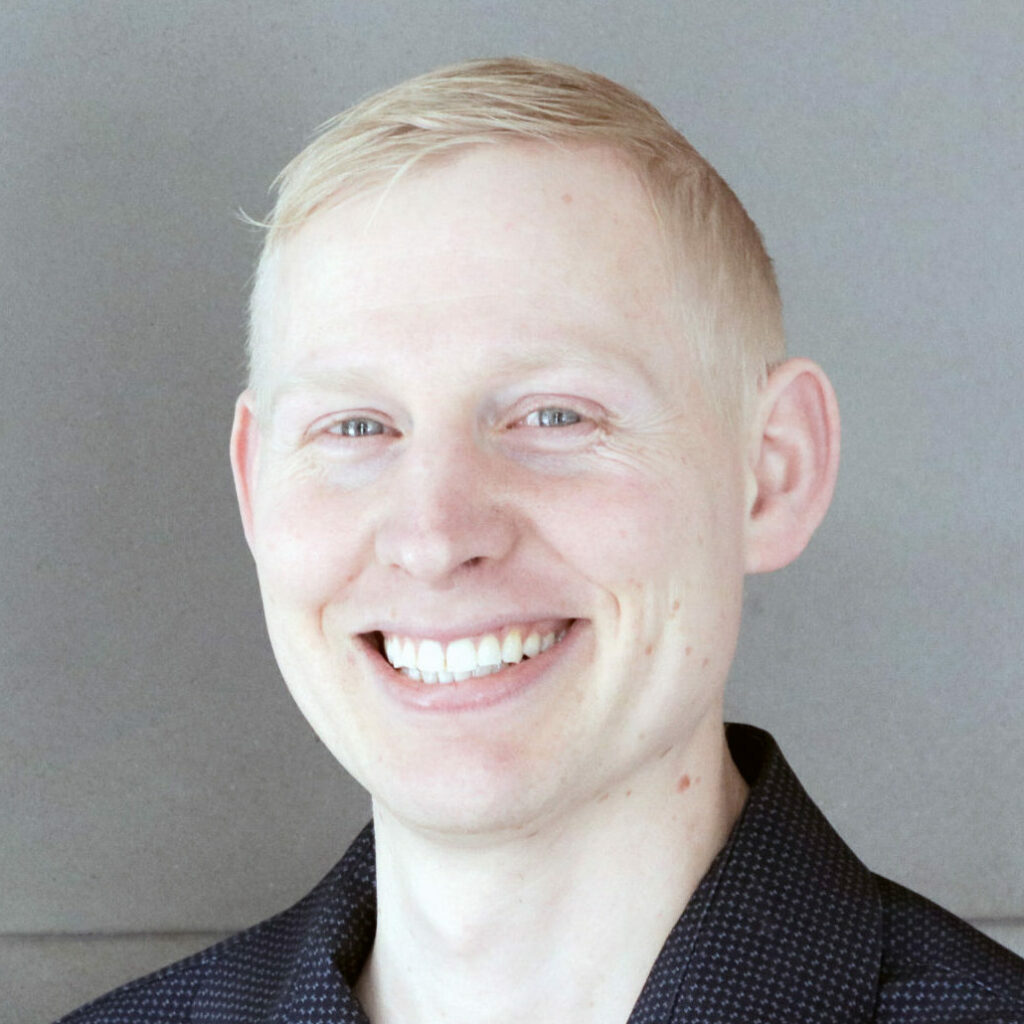
Nathan Strenge
Senior Learning Designer
nathan.strenge@fieldingintl.com
Eden Park Elementary: A Glimpse Behind the Scenes
I love observing life at Eden Park Elementary School. Watching students and teachers flow through the space feels a bit magical: kids look comfortable and engaged, and teachers communicate and share responsibilities with each other. There’s this underlying vibe that seems to both calm and energize people simultaneously. It doesn’t take long to see that deep learning, strong relationships, and a commitment to wellness are integral parts of the culture…
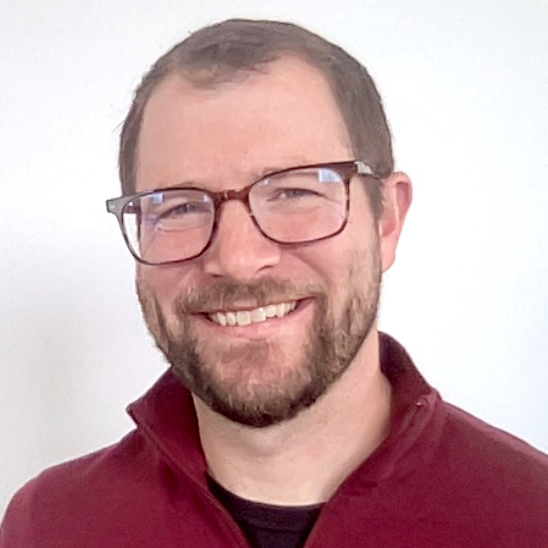
Mike’s Thoughts: What is a Learning Community?
June 13, 2023 / Video Part 1 of 5
The Future-Ready School: Harnessing the Power of Learning Communities in Education
The post-COVID world presents unique challenges for education globally. With declining engagement rates, rising social-emotional learning needs, and the daunting reality of staff shortages, schools and districts worldwide are at a crossroads. However, as Eden Park Elementary School demonstrates, there may be a potent solution to these challenges – the transformative power of collaborative learning communities.
Eden Park Elementary has committed to creating the ideal conditions for future-ready learning. They’ve reshaped a wing of their school into a collaborative learning community. This new approach replaces traditional classrooms with ‘studios,’ common areas, and specialized labs for scientific experiments or design thinking. Small group rooms allow for intervention and student support services or peer-to-peer collaboration. Teachers have a dedicated workspace where they can collaborate, reflect, and recharge. The defining quality of a learning community is that there is a culture of learning, in which everyone is involved in a collective effort of understanding. (Bielaczyc & Collins, 1999).
In the video above, Principal Courtney Sevigny takes us on a tour, showing us how this strategic spatial restructuring has sparked a paradigm shift in teaching and learning. At Eden Park, the teachers have moved away from isolated classrooms to a collective model, thinking of every student and the entire wing as ‘ours.’ This shared sense of ownership has created a more inclusive, supportive learning environment, increasing students’ feelings of belonging and high-quality learning habits.
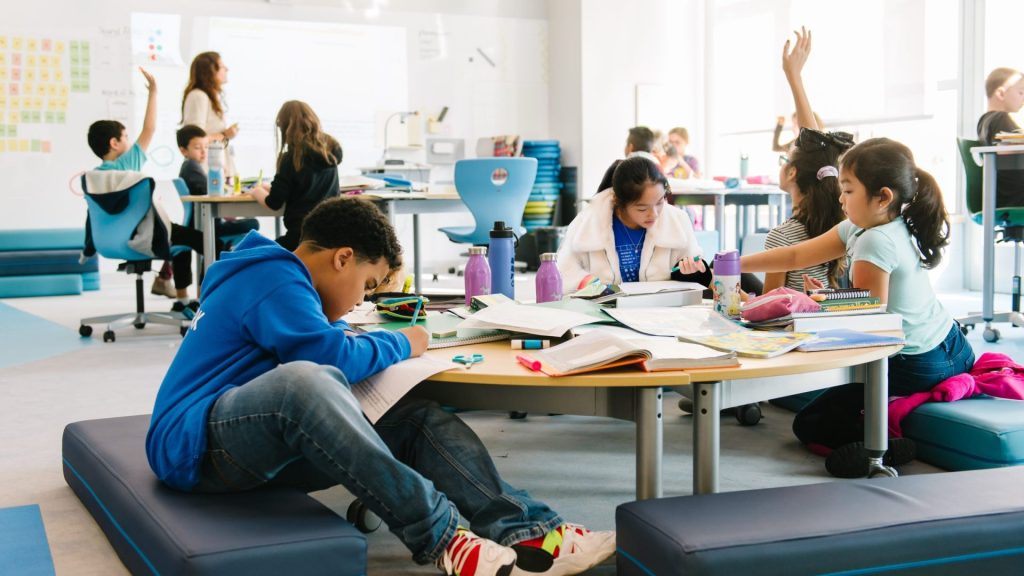
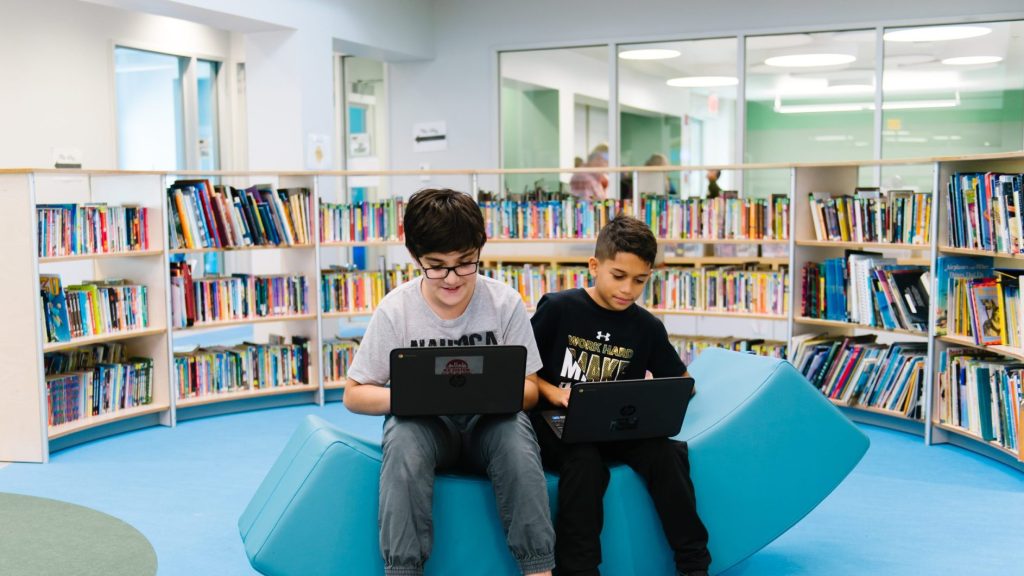
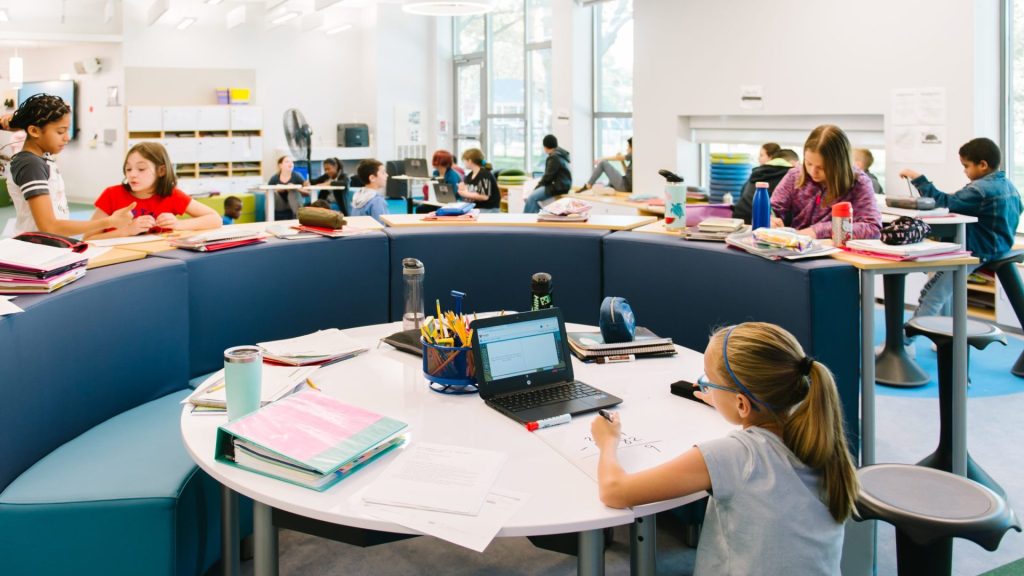
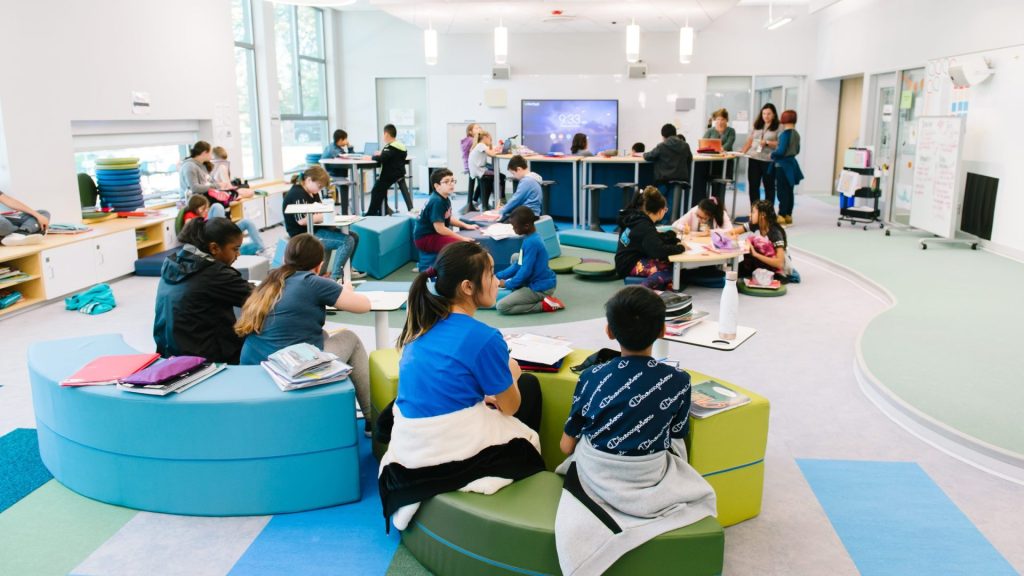
Belonging is a critical component in learning communities. These environments cultivate interactivity and collaboration, making students feel valued and connected (Osterman, 2000). This sense of community can counter the current engagement crisis, as a feeling of belonging is a crucial aspect of student engagement (Furrer & Skinner, 2003).
But the benefits of learning communities don’t stop there. They also foster social-emotional learning by increasing social interaction between students, adult mentors, and peers. This networked approach provides students with necessary emotional support while modeling constructive social behavior. Studies show that these relationships can enhance students’ social-emotional competencies, contributing to their overall success (Durlak, Weissberg, Dymnicki, Taylor, & Schellinger, 2011).
In the current climate of school staff shortages and frequent changes, learning communities also offer resilience and adaptability. A team of educators shares responsibility, enabling smooth transition and continuity in students’ learning experiences when a substitute teacher isn’t available or a sudden shift occurs. This collective team approach ensures that every student receives consistent support and guidance, making learning communities a model of resilience in today’s ever-evolving educational landscape.
However, it’s not just the students who benefit. Learning communities also foster a collaborative and supportive environment for educators. Teachers build stronger relationships through daily collaboration, which leads to the sharing of effective teaching practices and natural mentorship opportunities. Such an environment enhances job satisfaction and fosters professional growth, further solidifying the community’s resilience (Hargreaves & O’Connor, 2018).
So, what can other schools learn from Eden Park Elementary?
Start small and try a ‘Pathfinder.’ Transforming a single classroom or introducing collaboration within a grade level can provide a testing ground for the model. Encourage a shared sense of ownership among educators. Facilitate increased interaction between students and adult mentors, and foster a learning environment that nurtures belonging.
Reach out to our Learning Design team by contacting Mike at michael.posthumus@fieldingintl.com to learn how we help schools audit and imagine new learning environment opportunities using a collaborative design process
Eden Park Elementary School offers a hopeful lens into the future of education. By embracing innovation, collaboration, and a forward-thinking mindset, they have shown us how to engage students effectively, support their emotional growth, and foster resilient educational environments.
What about your school or district? What innovations are you considering or have you implemented to address these modern educational challenges? Share your experiences with us!
References:
Bielaczyc, K., & Collins, A. (1999). Learning Communities in Classrooms: A Reconceptualization of Educational Practice. Instructional-Design Theories and Models: A New Paradigm of Instructional Theory, 2, 269-292.
Durlak, J. A., Weissberg, R. P., Dymnicki, A. B., Taylor, R. D., & Schellinger, K. B. (2011). The Impact of Enhancing Students’ Social and Emotional Learning: A Meta-Analysis of School-Based Universal Interventions. Child Development, 82(1), 405-432.
Hargreaves, A., & O’Connor, M. T. (2018). Collaborative Professionalism: When Teaching Together Means Learning for All. Corwin.
Osterman, K. F. (2000). Students’ Need for Belonging in the School Community. Review of Educational Research, 70(3), 323-367.

Nathan’s Thoughts: What is a Learning Community?
June 13, 2023 / Video Part 1 of 5
I love observing life at Eden Park Elementary School. Watching students and teachers flow through the space feels a bit magical: kids look comfortable and engaged, and teachers communicate and share responsibilities with each other. There’s this underlying vibe that seems to both calm and energize people simultaneously. It doesn’t take long to see that deep learning, strong relationships, and a commitment to wellness are integral parts of the culture. Because I had witnessed these things in the past, it was an honor to be able to help direct this series of films so a wider audience can get a glimpse of what’s happening at Eden Park. My goal in this series of blogs associated with the launch of the films is to provide additional insights into what it was like being on the ground and to give “reflection questions” to use as a watch guide.
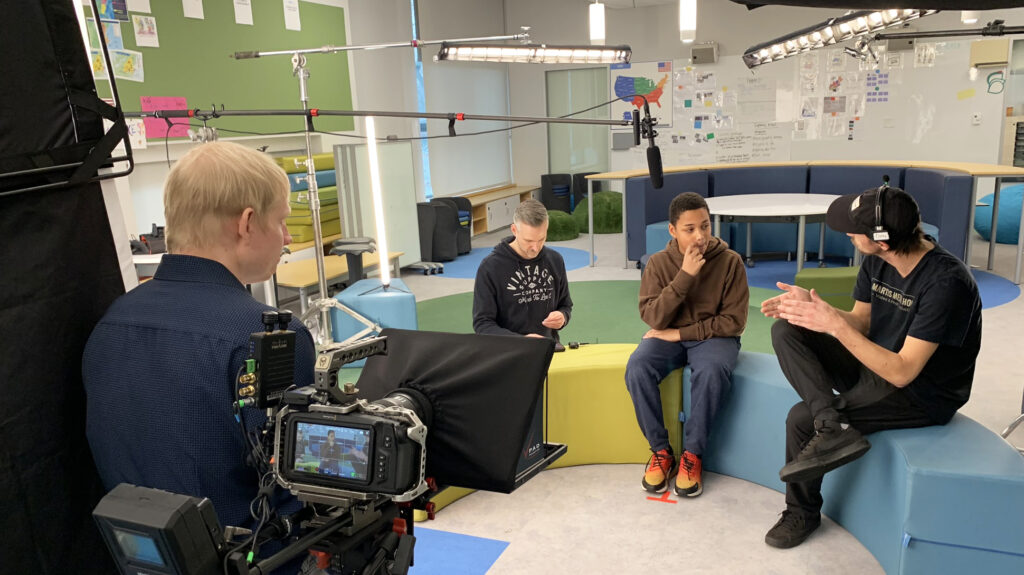
Talking to students and educators throughout the filming process, it became evident that the variety of dynamic spaces purposefully designed to foster active, student-centered, & collaborative teaching and learning has been a catalyst for their positive experiences. Students repeatedly mention how the small group rooms attached to learning studios as well as the learning commons give them the freedom to move as needed. They share how the variety of furniture allows them to find the spot that they need at any given time. Teachers talk about how welcoming the spaces are and the sense of holistic safety they provide. They say how the flexibility of the environment helps to get to know students and adapt to each one’s unique set of needs.
As you watch this first film in the series, consider reflecting on the following set of questions:
- At the 2:00 mark, you see “before” and “after” pictures that show the conversion from a hallway to a learning commons. What is your reaction to this transformation?
- Near the end of the video, Principal Sevigny says, “At the end of the day, it isn’t about any one of these spaces, but how they work together to create a connected environment where our students are free to move, to be seen, and to engage in all kinds of different learning experiences.” How does this description compare to your own experiences in school?
- What stands out to you from Principal Sevigny’s tour through the Learning Community?
Student Perspectives on Learning Communities
June 21, 2023 / Video Part 2 of 5

Michael Posthumus
Learning Design Principal
mike.posthumus@fieldingintl.com
Transforming Our Schools for the Modern Learner
In today’s rapidly evolving world, the way we teach and learn is under scrutiny, and the traditional “chalk and talk” method just isn’t cutting it anymore. A recent Gallup report amplifies this sentiment, underscoring the struggles K-12 schools face in engaging and inspiring a new generation of digitally native, diverse, and expectation-rich students who recently experienced a huge range of opportunities, and challenges through their schools’ responses to COVID-19.

Nathan Strenge
Senior Learning Designer
nathan.strenge@fieldingintl.com
In today’s education landscape, “student voice” and “youth empowerment” are popular catchphrases. It’s understandable – there’s a growing recognition that giving young people more say and more ownership in their educational journey has profound, transformative benefits for learning. The ability for students to have a legitimate voice in things such as how they learn, what they learn, when they learn, and where they learn has tremendous potential for schools to adapt to the unique needs and gifts of every individual. However, there’s a glaring disconnect between the popularization of these terms and their actual implementation in many schools.

Mike’s Thoughts: Student Perspectives on Learning Communities
June 21, 2023 / Video Part 2 of 5
Transforming our Schools for the Modern Learner
In today’s rapidly evolving world, the way we teach and learn is under scrutiny, and the traditional “chalk and talk” method just isn’t cutting it anymore. A recent Gallup report amplifies this sentiment, underscoring the struggles K-12 schools face in engaging and inspiring a new generation of digitally native, diverse, and expectation-rich students who recently experienced a huge range of opportunities, and challenges through their schools’ responses to COVID-19.
Modern learners are navigating a world steeped in digital technology, craving educational experiences that are interactive, relevant, and meaningful. Yet, many schools are wrestling to deliver such experiences. Why? The answer lies in the glaring mismatch between conventional teaching methodologies, environments, resources, and today’s learner needs.
As educators and facility designers, we’re at the forefront of impacting, and hopefully transforming this landscape. To adapt, we need to embrace trends that align with our learners’ realities: personalized learning, blended and digital experiences that build real, usable, and relevant skills, social-emotional learning that fosters agency and self-knowledge, and competency-based education to prepare learners for their futures. Each of these approaches promises to make learning more engaging, effective, and aligned with the world our students will graduate into.
Personalized learning tailors the educational experience to each student’s pace, strengths, and interests, leading to higher student achievement. Blended learning integrates technology into traditional classroom instruction, bolstering student engagement and making learning more interactive. Social-emotional learning cultivates emotional well-being, leading to better academic performance, while competency-based education allows students to learn at their own pace, promoting deeper understanding.
In order to effectively manage this educational shift, schools must engage in three strategic directions that have been widely supported in research.
First, educators must be equipped with the skills and knowledge needed to integrate technology effectively into their teaching practices and implement personalized learning. According to a study by Ertmer and Ottenbreit-Leftwich (2017), effective technology integration relies heavily on the teachers’ ability to balance their technological knowledge with their pedagogical and content knowledge, a concept known as Technological Pedagogical Content Knowledge (TPACK). Additionally, a review by Pane and Steiner (2019) emphasizes that teachers require professional development and ongoing support to implement personalized learning strategies effectively. We have to invest in educators to catalyze change in education. Unfunded, untrainable, unrealistic policy changes without investment and adequate resources or human support will continue to yield poor results and little progress in improving our schools.
Second, schools need to foster a culture of continuous innovation and improvement. This means cultivating an environment that encourages risk-taking, experimentation, and learning from failures, as well as successes. A study by Kraft et al. (2018) found that schools fostering a culture of continuous improvement were more successful in improving student outcomes. Similarly, Thoonen et al. (2011) highlights the importance of school leadership in fostering such a culture.
Lastly, transitioning to a more student-centric approach is crucial. A review by Zhao et al. (2019) emphasizes that student-centered learning environments can significantly enhance student motivation and academic performance. This approach prioritizes the unique learning needs and aspirations of each student and allows them to take ownership of their learning journey. Flexible learning environments like the space at Eden Park have centered their approach to school around students and the results show up in their voices.
Implementing these strategies is not a straightforward task. It requires a coordinated effort from educators, administrators, policy-makers, and students themselves. But the rewards – improved student engagement, better learning outcomes, and a more relevant education – make it a worthwhile pursuit. The exciting student reactions from the featured video echo the potential impact of such changes. These innovative spaces aren’t just aesthetically pleasing; they signify a critical paradigm shift – a move towards a more interactive, collaborative, and flexible education model that resonates with our students.
The connection between learning spaces and educational outcomes has been the focus of extensive research. Barrett et al. (2015) found that well-designed learning environments can boost student performance by 16%, with aspects like light, temperature, and flexibility playing key roles. Flexible classrooms have been shown to foster creativity, collaboration, and active learning, encouraging students to take charge of their learning journey (Blackmore et al., 2011). The student reactions demonstrate the impact of such changes. Beyond their aesthetic appeal, these innovative spaces symbolize a critical paradigm shift towards a more engaging, dynamic education model.
As educators and facility designers, thoughtfully designed flexible learning spaces give us a potent tool to make the education process more aligned with our learners’ needs and aspirations. They offer us an opportunity to reshape our classrooms into not just spaces for instruction, but platforms for exploration, innovation, and collaboration.
So, let’s embrace a new learning environment, not just in our classrooms, but in our approach to education. By doing so, we can make learning a journey that truly excites, engages, and prepares our young people for a future brimming with possibilities. Change is seldom easy, but it is necessary. After all, we’re not just teaching subjects, we’re shaping futures. Let’s make sure we’re shaping the best ones possible.
References:
Barrett, P., Zhang, Y., Moffat, J., & Kobbacy, K. (2013). A holistic, multi-level analysis identifying the impact of classroom design on pupils’ learning. Building and Environment, 59, 678-689.
Blackmore, J., Bateman, D., Loughlin, J., O’Mara, J., & Aranda, G. (2011). Research into the connection between built learning spaces and student outcomes. Education Policy and Research Division, Department of Education and Early Childhood Development, 1-84.
Ertmer, P. A., & Ottenbreit-Leftwich, A. T. (2017). Removing obstacles to the pedagogical changes required by Jonassen’s vision of authentic technology-enabled learning. Computers & Education, 107, 165-181.
Kraft, M. A., Blazar, D., & Hogan, D. (2018). The effect of teacher coaching on instruction and achievement: A meta-analysis of the causal evidence. Review of Educational Research, 88(4), 547-588.
Pane, J.F., & Steiner, E.D. (2019). New approaches to measuring the impacts of personalized learning. Journal of Educational Measurement, 56(2), 357-375.
Thoonen, E. E., Sleegers, P. J., Oort, F. J., Peetsma, T. T., & Geijsel, F. P. (2011). How to improve teaching practices: The role of teacher motivation, organizational factors, and leadership practices. Educational Administration Quarterly, 47(3), 496-536.
Zhao, N., & Zhou, G. (2019). Two decades of research on self-regulated learning in online learning: A systematic review of the use of self-regulated learning in online learning studies. Distance Education, 40(3), 334-354.

Nathan’s Thoughts: Student Perspectives on Learning Communities
June 21, 2023 / Video Part 2 of 5
In today’s education landscape, “student voice” and “youth empowerment” are popular catchphrases. It’s understandable – there’s a growing recognition that giving young people more say and more ownership in their educational journey has profound, transformative benefits for learning. The ability for students to have a legitimate voice in things such as how they learn, what they learn, when they learn, and where they learn has tremendous potential for schools to adapt to the unique needs and gifts of every individual. However, there’s a glaring disconnect between the popularization of these terms and their actual implementation in many schools (Mitra, 2018).
Over my career I’ve worn many hats in education: classroom teacher, school founder, leadership coach, design consultant, and more. These experiences have given me the opportunity to really dig into how we can amplify youth voices and how we can empower young people; what I see is that many of the well-intentioned efforts schools are making to do this fall well short of what our students deserve. For instance, giving kids an hour of unstructured time once a week in a Genius Hour is progress, but it doesn’t address what happens in the other 39 hours. So, what does genuine empowerment actually look like? To put it simply, empowerment is a function of the level of freedom students have to navigate time and space in their everyday school experiences.
Through that lens, Eden Park Elementary School stands out as an exemplary model of genuine student empowerment. Here, 3rd-5th graders in the Learning Community have a tremendous amount of control to determine how they flow through the day.
During filming, students repeatedly told us the spaces they have access to are a big part of why they feel empowered. The proximity and transparency of the small group rooms to the classrooms make for a great breakout. The commons feel welcoming and comfortable, an agile place that allows students to spread out and find a quiet area when needed, or actively work on a project as a team. The variety of furniture students can arrange and rearrange encourages more movement, more active learning, and a greater sense of autonomy.
One of Eden Park’s students, Josephina, succinctly sums up the importance of such empowerment: “Freedom helps you learn; because without freedom, kids wouldn’t really want to go to school.” It’s through this profound understanding of the role of freedom in learning that Eden Park Elementary is raising the bar in fostering student empowerment.
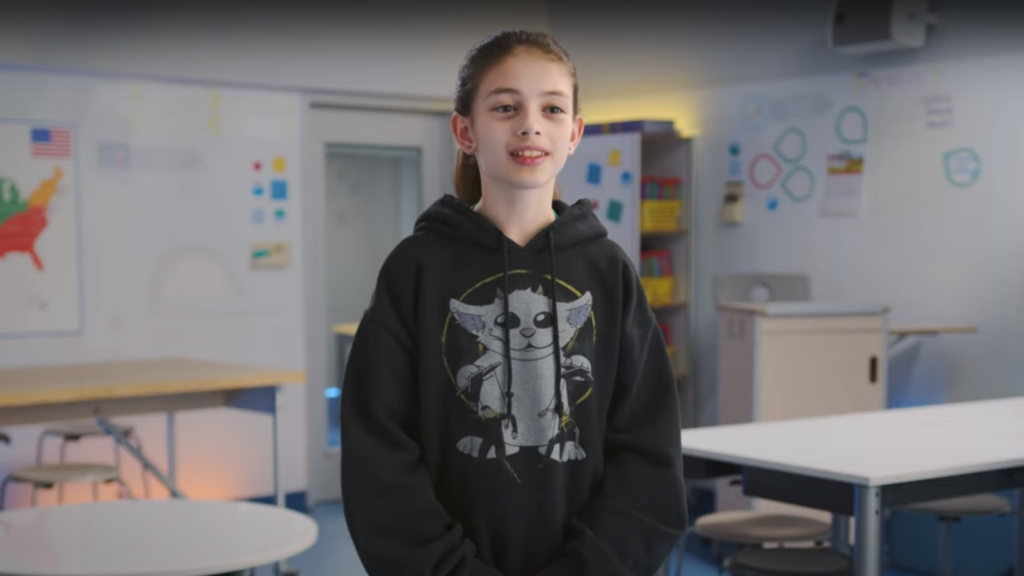
This model serves as a powerful reminder of the significant impact a true commitment to youth voice can have on the education system, and how reimagining physical space can unlock genuine student empowerment.
Guiding Questions:
- Many of the students talk about the ability to move in the Learning Community. Why do you think they see their ability to move as so important?
- Multiple students remark that the commons is their favorite place in the Learning Community. Based on the images that you see of the commons in the video, what do you observe that makes it a desirable location?
- Where does your head go when you hear Josephina’s remark, “Freedom helps you learn; because without freedom, kids wouldn’t really want to go to school?”
References:
Mitra, D. (2018), “Student voice in secondary schools: the possibility for deeper change”, Journal of Educational Administration, Vol. 56 No. 5, pp. 473-487. https://doi.org/10.1108/JEA-01-2018-0007
Reflections from the Educators
July 27, 2023 / Video Part 3 of 5

Michael Posthumus
Learning Design Principal
mike.posthumus@fieldingintl.com
School Resilience and Educator Efficacy: The Power of Flexible Learning Environments
In the evolving landscape of education, professional learning stands as a powerful catalyst to foster teacher or system resilience, effectiveness, and job satisfaction. But how can we make the profession more rewarding and impactful? Schools around the world are realizing that their flexible learning environments are improving conditions for educators’ well-being, helping build stronger teams, improving culture, and benefiting students as a result.

Nathan Strenge
Senior Learning Designer
nathan.strenge@fieldingintl.com
Having spent a decade as a high school math teacher, I became intimately aware of the isolation that accompanies traditional classroom teaching. Despite a mere wall separating my classroom from my peers, institutionalized time structures and an inflexible curriculum made genuine collaboration feel like an arduous uphill battle. Our work was siloed, denying us the opportunity to learn from each other and enrich our teaching through cross-disciplinary experiences. There are many reasons teachers are burning out and leaving the profession at alarming rates, and isolating work environments is certainly a significant factor.

Mike’s Thoughts: Reflections from the Educators
July 27, 2023 / Video Part 3 of 5
School Resilience and Educator Efficacy: The Power of Flexible Learning Environments
In the evolving landscape of education, professional learning stands as a powerful catalyst to foster teacher or system resilience, effectiveness, and job satisfaction. But how can we make the profession more rewarding and impactful? Schools around the world are realizing that their flexible learning environments are improving conditions for educators’ well-being, helping build stronger teams, improving culture, and benefiting students as a result.
Flexible learning environments are not just for students. These spaces serve as hubs for professional development, nurturing a collaborative culture and fostering professional learning communities (PLCs). The PLC model offers a collaborative approach to professional development, allowing educators to share expertise, exchange ideas, and learn from each other in a real-time, practical setting (Hord, 2009). A study by Waldron and McLeskey (2010) found that schools that implemented the PLC model in a flexible learning environment experienced increased teacher effectiveness, improved student achievement, and a more positive school culture.
In these flexible spaces, teachers become students, learning and seeing new teaching methodologies, integrating technology effectively, and understanding diverse student needs alongside their peer educators without the siloed classroom that has traditionally contained educators for the spirit of collaboration that is so widely discussed in education circles. The interactive nature of these environments supports real-time feedback, peer observation, and co-teaching, enhancing the quality of professional learning and implementation of high-quality practices that help kids (Trust, Krutka, & Carpenter, 2016).
Beyond enriching teaching methods and enhancing student engagement, flexible learning environments also serve a more pragmatic function in bolstering the resilience of staffing structures. The inherent adaptability of these environments allows for seamless adjustment in cases of unforeseen adult absences, ensuring continuity in student learning. Instead of traditional isolated classrooms that depend heavily on the presence of a single teacher, the fluid structure of flexible learning spaces fosters a sense of shared responsibility among educators, promoting cross-functional teamwork.
The malleability of these spaces supports unanticipated shifts in a school’s day-to-day operations, effectively accommodating spur-of-the-moment events or sudden changes in school routines. For example, a flexible learning space can swiftly transition from a collaborative group work setup to a lecture-style arrangement for a surprise guest speaker or can be rearranged to host an impromptu school assembly or event.
But the power of flexibility extends beyond physical space and into the teaching strategies employed. It empowers teachers to pivot their instructional methods as needed, honing practices in real time based on student feedback and peer input. This dynamic, responsive approach builds a more resilient teaching community that can adapt swiftly to changing educational circumstances or challenges. Flexible learning environments are not just about providing versatile spaces; they’re about nurturing an adaptable, resilient, and collaborative educational community that can thrive in the face of both routine and unexpected challenges.
So, if you’re an educator or school administrator looking to invigorate professional learning and practices while making your system more resilient, it’s time to embrace the type of flexibility demonstrated at Eden Park. By transforming a block of classrooms into dynamic, collaborative spaces that are collectively shared and understood as environments to help all students learn, we can catalyze professional growth, foster resilience, and ultimately, enhance the quality of education we deliver to our students. As always, email me to talk more about the specific challenges you are facing in your buildings and the models we could explore to meet your specific programming needs.
References:
Hord, S. M. (2009). Professional learning communities. Journal of Staff Development, 30(1), 40-43.
Trust, T., Krutka, D. G., & Carpenter, J. P. (2016). “Together we are better”: Professional learning networks for teachers. Computers & Education, 102, 15-34.
Waldron, N. L., & McLeskey, J. (2010). Establishing a collaborative school culture through comprehensive school reform. Journal of Educational and Psychological Consultation, 20(1), 58-74.

Nathan’s Thoughts: Reflections from the Educators
July 27, 2023 / Video Part 3 of 5
Having spent a decade as a high school math teacher, I became intimately aware of the isolation that accompanies traditional classroom teaching. Despite a mere wall separating my classroom from my peers, institutionalized time structures and an inflexible curriculum made genuine collaboration feel like an arduous uphill battle. Our work was siloed, denying us the opportunity to learn from each other and enrich our teaching through cross-disciplinary experiences. There are many reasons teachers are burning out and leaving the profession at alarming rates, and isolating work environments is certainly a significant factor (Tabancali 2016).
Yet, it doesn’t have to be this way. A beacon of hope is offered by Eden Park Elementary’s shift from isolated classrooms to a Learning Community model. The testimonies of these teachers, who have successfully navigated this transformation, are inspiring.
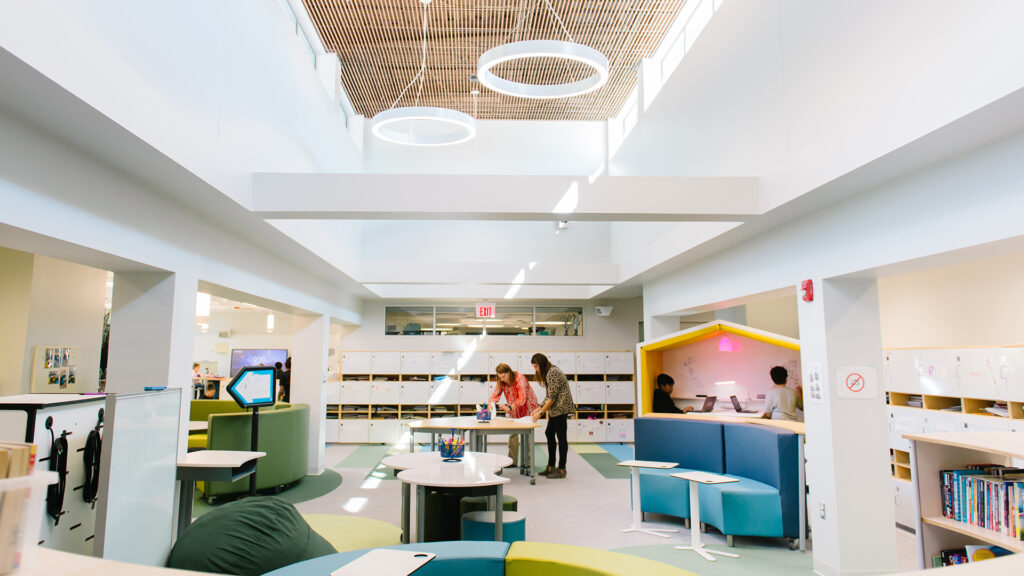
They reflect on the newfound transparency and spatial diversity that catalyzes positive peer support, fostering pedagogical growth and innovation. No longer are students compartmentalized by classroom walls; the shift from “my students” to “our students” has nurtured stronger relationships and a collective sense of responsibility for learners.
The Learning Community model also empowers students with choice and autonomy, cultivating their agency and enthusiasm for learning. One nugget that didn’t make the final video cut, but an important point the teachers made: this shift to greater student choice and autonomy has led to fewer behavior problems, favorably moving teachers away from their undesirable role as “classroom manager.” These changes liberate teachers from traditional confines, able to adopt more creative, project-based approaches that breathe life into their craft.
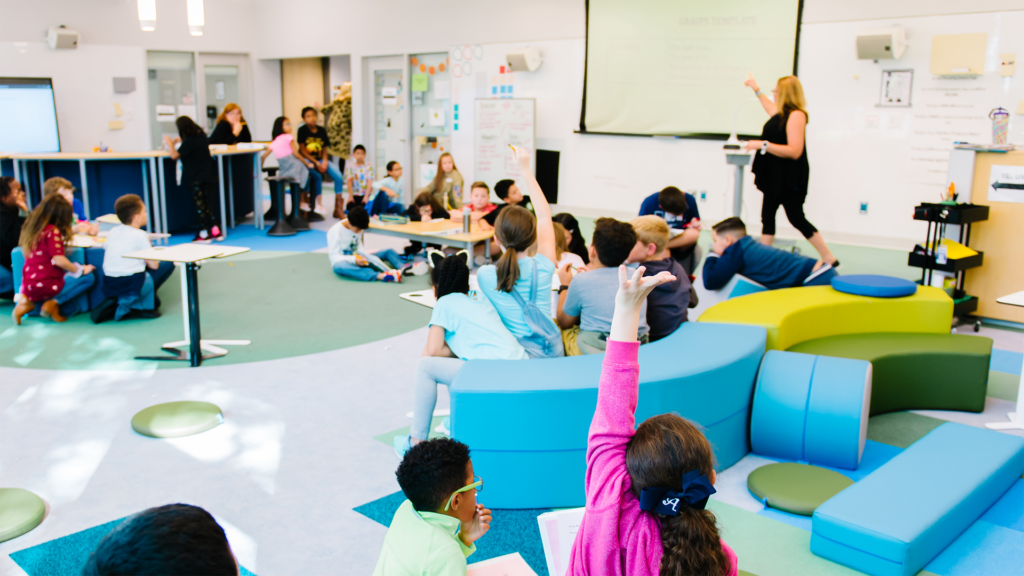
Eden Park Elementary highlights the benefits of deconstructing classroom isolation. The transformation has unlocked a trove of pedagogical possibilities, kindling the spark for innovation and shared growth. And most importantly, the ultimate beneficiaries are the students, who experience a richer, more integrated learning journey.
Teaching in isolation need not be the status quo. Eden Park offers a promising blueprint for a new, collaborative future in education. Can your school benefit from some of the magic going on at Eden Park?
Guiding Questions:
- At the start of the film, Lisa Salisbury talks about transparency as a driving force to use and utilize each other’s resources. Where do you see transparency show up in the video?
- Several teachers talk about their feelings of isolation before the change to the Learning Community. How do you relate to this?
- Student choice in how they interact with the environment is cited by teachers as a significant benefit in a Learning Community. As you watch, how many types of ways do you see students choosing to engage in their learning?
References:
Tabancali, E. (2016). The relationship between teachers’ job satisfaction and loneliness at the workplace. Eurasian Journal of Educational Research, 66, 263280, http://dx.doi.org/10.14689/ejer.2016.66.15
Best Practices in a Learning Community
August 17, 2023 / Video Part 4 of 5

Michael Posthumus
Learning Design Principal
mike.posthumus@fieldingintl.com
The Future of Schools: From “My Classroom” to “Our Community”
In the ever-evolving world of education, there is an important question educators must reflect upon: “How can we design a learning community that balances both the demands of our district and prescribed curriculum with the unique holistic human needs of our community, ensuring neither is compromised?” The answer to this question holds the key to the future of schools and the essence of progressive education…

Nathan Strenge
Senior Learning Designer
nathan.strenge@fieldingintl.com
Addressing the Reluctancy to Transform
While planning this short film in partnership with the dedicated educators at Eden Park Elementary School, a resonant theme emerged – the importance of preserving existing best teaching practices even as we innovate. As a classroom teacher of a decade, this insight instilled in me a profound hope for the evolution and expansion of future Learning Communities…

Mike’s Thoughts: Best Practices in a Learning Community
August 17, 2023 / Video Part 4 of 5
The Future of Schools: From “My Classroom” to “Our Community”
In the ever-evolving world of education, there is an important question educators must reflect upon: “How can we design a learning community that balances both the demands of our district and prescribed curriculum with the unique holistic human needs of our community, ensuring neither is compromised?” The answer to this question holds the key to the future of schools and the essence of progressive education.
For this model to truly succeed, educators and students must collaboratively define what successful teaching and learning look like, emphasizing a balanced focus on well-being and academic growth. A school isn’t just about imparting knowledge; it’s about nurturing holistic growth. Importantly, every voice should be part of this dialogue, including students of all ages, abilities, and levels of engagement. They are, after all, central to the learning process.
Historically, the scales have often tipped toward either the well-being of students or academic rigor. Yet, this dichotomy is being challenged. For instance, Eden Park Elementary stands as a shining example of a school that has harmoniously blended these elements, crafting innovative strategies and routines that can inspire countless others.
Their approach hinges on two fundamental principles: student-centered inquiry, epitomized by project-based learning, and the ethos of collective efficacy. Both concepts represent a research-based and paradigm-altering shift in how schools generally deliver education to students around the world.
Project-based, student-centered pedagogies empower students to take charge of their learning journey. This prescribed autonomy and agency foster a sense of community ownership. The results are palpable: students are more enthusiastic about learning, display increased responsibility, and the essence of community shines brighter. Every student becomes a potential mentor, collaborator, or friend, echoing the real-world dynamics of society.
Mirroring this student experience, educators too are embracing the concept of collective efficacy. Recognizing that the true impact on student learning arises when they operate cohesively and collaboratively, teachers are moving beyond the isolated silos of “My Classroom” or “My Students.” The shift is towards a more collaborative, compassionate, and empathetic stance, transforming the narrative to “Our Learning Experience” and “Our Successes.”
The journey from an “I” or “My” perspective to an “Our” perspective is pivotal. Schools that have begun this journey often report to our educators how impactful, yet challenging the journey can be for educators. But this transcends beyond educators and is a paradigm shift that can redefine schools of the future because of the impact it has on our learners, families, and communities. As educators, embracing a collectivist mindset allows for a more inclusive, holistic, and enriching educational experience, the true essence of a learning community. The future of schools is not just about individual achievements but shared triumphs, collective growth, and community resilience.

Nathan’s Thoughts: Best Practices in a Learning Community
August 17, 2023 / Video Part 4 of 5
Addressing the Reluctancy to Transform
While planning this short film in partnership with the dedicated educators at Eden Park Elementary School, a resonant theme emerged – the importance of preserving existing best teaching practices even as we innovate. As a classroom teacher of a decade, this insight instilled in me a profound hope for the evolution and expansion of future Learning Communities.
Knowing how many teachers are struggling with the weight of teaching in an isolated environment and feeling overwhelmed to engage kids in an age where mental health needs are vast, Learning Communities offer a more collaborative and holistically supportive environment for kids and adults alike.
So why is their insight about preserving existing best teaching practices so important? It has to do with the reluctance some schools have to move away from a classroom-based spatial model, even if they see its limitations.
There’s little question why a classroom-based approach to schooling has had such a profound staying power (hint: it’s not because it’s best for kids). To put it simply: it’s what we know. Here in the United States, the vast majority of adults alive today went to schools using a classroom model. Today’s teachers were trained to teach in a classroom and have a lifetime of experiences in a classroom. Because of this familiarity and its effects on operating a school building, classroom-based models continue to be designed and built.
Compounding the “it’s what we know” problem is how little the K-12 education industry has invested in research and development. From a report by Aaron K. Chatterji at Duke University, “Research and development (R&D) accounts for a tiny share of total expenditures in K–12 education, around 0.2%, or 1/50 the rate of the most innovative industries” (quote from Chatterji, 2017).
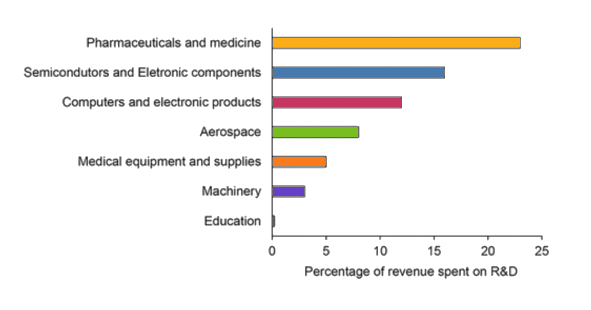
Despite these historical factors, many communities are beginning to see the limitations of a classroom-based approach. Schools are recognizing that giving young people more agency to move around to find the right place at the right time is essential to wellness and student-centered learning. That level of authentic student agency requires a variety of safe, desirable environments that are highly accessible. Creating a diverse array of environments that meet the spectrum of needs of any group of kids is practically impossible within the four walls of a classroom, but it’s what defines a well-designed Learning Community.
As more and more schools embrace different spatial models, it has to be very reassuring for classroom-based teachers to hear from Eden Park educators that maintaining existing best teaching practices is important. I am hopeful that hearing this insight will alleviate some of the fear caused when considering transitioning to Learning Communities.
Guiding Questions:
- What are the tangible ways you see in this video in which teachers give students a real sense of ownership?
- What are some teaching practices that you believe would carry over from a classroom model to a Learning Community?
- Near the end of the video, Principal Sevigny references their previous spatial model, expressing “No one here would want to go back.” From what you’ve seen and heard from these educators, why do you think that is?
References:
Chatterji, A. (2017). Innovation and American K-12 Education. The University of Chicago Press Journals. https://doi.org/https://www.journals.uchicago.edu/doi/full/10.1086/694406#d5731612e1
Starting Strong in a Learning Community
September 13, 2023 / Video Part 5 of 5

Michael Posthumus
Learning Design Principal
mike.posthumus@fieldingintl.com
Future Ready?
The video showcasing Eden Park Elementary School’s effective approach to starting the school year isn’t just a heartening vignette—it shares a blueprint for what future-ready education should aspire to be. I’d like to zoom out and underline a foundational principle of future-ready schools: the radical importance of empowering educators to design student-centered experiences…

Nathan Strenge
Senior Learning Designer
nathan.strenge@fieldingintl.com
This video was truly a joy to produce. When talking to the Eden Park teachers to understand what they do to start each school year strong, it became clear how much they lean into student voices to create shared expectations. It’s a compassionate approach. They invest time to co-create expectations at the start because they recognize the level of trust it builds and allows them to do extraordinary things throughout the entire year, including trusting students with a lot of freedom…

Mike’s Thoughts: Starting Strong in a Learning Community
September 13, 2023 / Video Part 5 of 5
Future Ready?
The video showcasing Eden Park Elementary School’s effective approach to starting the school year isn’t just a heartening vignette—it shares a blueprint for what future-ready education should aspire to be. I’d like to zoom out and underline a foundational principle of future-ready schools: the radical importance of empowering educators to design student-centered experiences.
The “How Might We” Paradigm
Let’s not just talk about facilitating a project to start the year; let’s flip the script entirely. When educators are enabled to ask, “How might we create an environment where students feel heard, trusted, and engaged?” we unlock the door to a transformative educational experience. In schools organized by 19th and 20th-century principles, classrooms are often educator-centric, where students listen, the teacher speaks, and the room is pre-designed. Eden Park shows us that when the classroom is co-created, students invest not just in their education but also in their well-being.
Spaces that Speak
Designing the physical environment of a classroom shouldn’t just be about furniture or aesthetics; it should be an ongoing dialogue between the users and the space. Whether through learning walks to map out spaces or the ‘Zero Space’ concept where furniture is adaptable, when students actively participate in designing their environment, they become stakeholders in their educational journey. In an era where many students are disengaged from traditional learning, transforming the very space they occupy can have profound implications on their willingness to engage.
Cultural Co-Ownership
Creating a culture that shouts “This is OUR space” can be a subtle but powerful revolutionary concept in schools. Co-ownership of space spills over to co-ownership of community values, educational outcomes, and ultimately, one’s life trajectory. In a world obsessed with individual achievement, teaching students to co-create, share, and resolve conflicts is not just refreshing—it’s vital. It prepares them for an interconnected world that values social and emotional intelligence just as much as it values “book smarts.”
The Big Idea
Student well-being isn’t an isolated issue arising in our post-covid reality—it’s intrinsically tied to the environments and systems we design. Eden Park offers us more than just good ideas; it offers a compelling case for empowering educators to shift from being mere disseminators of knowledge to architects of experiences that nurture the whole student. The time for this paradigm shift is not in the distant future; it’s now. When educators are empowered to design student-centered spaces, we inch closer to a vision of education that is not just informative, but transformative.

Nathan’s Thoughts: Starting Strong in a Learning Community
September 13, 2023 / Video Part 5 of 5
This video was truly a joy to produce. When talking to the Eden Park teachers to understand what they do to start each school year strong, it became clear how much they lean into student voices to create shared expectations. It’s a compassionate approach. They invest time to co-create expectations at the start because they recognize the level of trust it builds and allows them to do extraordinary things throughout the entire year, including trusting students with a lot of freedom. When teachers were talking about how they start the year strong in a Learning Community, I realized many of their practices apply to conventional classrooms as well.
Here are some of the teachers’ key insights, with an angle of how they might apply in conventional school environments.
Facilitate A Project to Start the Year
It’s about collaboration, connecting students, teachers, and staff in a cohesive project, thereby fostering unity and creativity. A classroom teacher can start the year with a “How might we…” question that gets their class engaged in a design challenge about making their room feel welcoming and comfortable. Consider giving students opportunities to engage with community members in hospitality to elicit advice, feedback, donations, etc. for their project.
Map Out Spaces
This involves planning and coordinating spaces to facilitate learning, ensuring that everyone is on the same page, and each space is utilized effectively. In a conventional school, go on a learning walk with students throughout the school where they document places that are uninviting and/or underutilized. Have them map their favorite spaces and brainstorm ways to overcome uninviting, underutilized environments.
Create Expectations For Furniture and Zero Space: Kids love choices to sit, stand, and move around their learning environment. A classroom teacher can advocate for a variety of furniture that gives students the freedom to have agency. Zero Space is the idea that kids can move furniture around to meet their needs, but before they leave the room it gets reset back to its base layout.
Establish a Culture That Is “OUR” Space
Eden Park Elementary School takes great pride in building a culture where every space is seen as co-owned and operated as a community. Teachers in classrooms can give this sense of co-ownership to their students, starting with minimal decorations and no clutter at the start of the year, and then working with students to transform the room into their own unique oasis.
Emphasize Community Values
In a Learning Community, knowing that sharing space can cause conflict, the instincts to give grace and learn from mistakes are remarkable deescalators. Helping young people develop these instincts through practice can be achieved no matter the environment. Identify natural points of conflict in your environment (i.e. some kids prefer the lights off for part of the day) and give students time to come up with solutions to propose and discuss with each other. Fostering this sense of collaborative problem-solving will help make the values you espouse become instinctive habits.
As a producer, I was inspired by the commitment of the teachers and the enthusiasm of the students. I witnessed firsthand how these principles weren’t mere words, but living practices that shaped everyday life at Eden Park Elementary School. The joy, the challenges, and the learning moments we shared while producing this film were nothing short of enriching. “Starting Strong in a Learning Community” isn’t just a film; it’s a reflection of a vision for education that is inclusive, engaging, and above all, human. It has been an honor to be part of this story, and I hope this short film serves as a beacon for anyone, regardless of their environment, to start every school year with compassion and relationships at the center.


